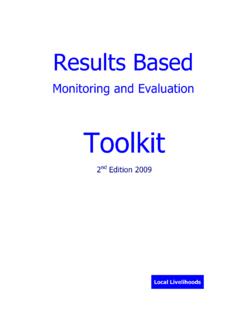Transcription of Analyzing stakeholders and power to identify advocacy …
1 Analyzing stakeholders and power to identify advocacy targets To undertake effective advocacy it is important to identify those who are most likely to be your allies, including those who can be persuaded to become allies, or at least facilitators to help you. You will also need to identify those who stand in the way of you achieving your advocacy goals. This section will help you to identify exactly who you need to persuade and influence to build a culture of evaluation. These are your advocacy targets. Most importantly, you need to tailor your ask according to what your targeted decision-maker is capable of delivering. Begin the process of identifying your target by taking note of all the stakeholders and actors involved in your particular stakeholder Analysis2 A stakeholder analysis highlights which institutions and individuals have a stake in an issue, as well as their interests, support or opposition, influence and importance.
2 A stakeholder analysis involves four steps: 1. identify the key stakeholders from the large array of groups and individuals that could potentially affect or be affected by the proposed intervention. For example, in building an enabling environment for evaluation, national stakeholders could include:3 National stakeholder Possible role and responsibility Senior government officials ( office of the president, office of the Prime Minister) Overall champion for the drive for results-based M&E in the public sector. Central agency ( ministry of finance or ministry of planning) Champion and facilitator for M&E development and implementation activities. Central coordinator for the roll-out of M&E across ministries. Government policy center for M&E guidance and guidelines for performance measurement, monitoring, evaluation and reporting. Establish a central M&E unit. Facilitate or manage high-level evaluations or special studies.
3 Monitor progress of M&E implementation across the system. Play oversight and quality control role for all M&E performance measurement and reporting. Establish an M&E professional development strategy for the country. Work with other partners in M&E capacity building initiatives: workshops, training, etc. Lead in the development of a national performance framework. Lead and coordinate preparation of any national performance report. Advise senior government officials on all M&E matters. Work with civil society and the private sector to promote feedback mechanisms as an input to M&E. Facilitate development of a national M&E professional association. 1 Adapted from WaterAid. (2007). The advocacy Sourcebook. 2 Adapted from UNEP-GPA, UNESCO-IHE, Train-Sea-Coast GPA. (2004). Improving Municipal Wastewater Management in Coastal Cities, Training Manual (Version 1).
4 3 UNEG Task Force on National Evaluation Capacity Development. (2012). National Evaluation Capacity Development: Practical tips on how to strengthen National Evaluation Systems. Individual ministries Establish internal M&E units. Establish senior-level M&E advisory committee for support and oversight of M&E initiatives. Develop a performance framework linking ministry programmes with sector goals. Develop a performance measurement strategy to clarify indicators and a cost-effective measurement strategy working with the central agency and the national statistical agency on data development strategy. Develop and implement ongoing monitoring systems for ministry programmes. Plan for and conduct periodic evaluations or special studies of programmes or sets of programmes. Annually report on programme results and sector performance Input to budget and policy discussions. Senior M&E committee Determine priorities for the conducting of high-level evaluation or special studies.
5 Provide a forum for review of findings and decisions for follow-up. Possible oversight role over the pace of national evaluation capacity development. National statistical agency Expertise on data capture and development. National survey capability. Central data storage. Focal point for national data development strategy. Assisting ministries with data development strategies. National audit office (NAO) Potential oversight role of M&E system (data audits on quality of data, quality of results-based performance reporting). Training institutions Potential partners national or regional university or a public sector training institute to help build M&E understanding through formal training. Civil society Advocate for equity-focused and gender-responsive evaluation systems Provide technical assistance as appropriate. Work with central agency and ministries to formalize ongoing or periodic feedback mechanisms.
6 Private sector Work with central agency and ministries to formalize ongoing or periodic feedback mechanisms. Other non-public agencies Potential partners with central agency and/or individual ministries in M&E development (where specific M&E pockets of knowledge/expertise exist). 2. Assess stakeholder interests and the potential impact of advocacy on these interests. Questions that you should try to answer in order to assess the interests of different stakeholders include: What are the stakeholder s expectations in advocating for an enabling environment for evaluation? What benefits are likely to result for the stakeholders from this advocacy work? What resources might the stakeholders be able and willing to mobilize for it? What stakeholder interests conflict with the advocacy goals? 3. Assess the influence and importance of the identified stakeholders . Influence refers to the power that the stakeholders might have in creating an enabling environment for evaluation.
7 This power may be in the form of stakeholders that have formal control over the decision-making process of it can be informal in the sense of hindering or facilitating the advocacy s implementation. Importance relates to how important the active involvement of the stakeholder is for achievement of the advocacy goal. stakeholders who are important are often stakeholders who are to benefit from the advocacy or whose objectives converge with the objectives of the advocacy . It is possible that some stakeholders who are very important might have very little influence and vice versa. 4. Outline a stakeholder participation strategy. This plan should state ways in which the different stakeholders will be involved in different stages of the advocacy planning and implementation. The involvement of stakeholders should be planned according to: Interests, importance, and influence of each stakeholder . Particular effort needed to involve important stakeholders who lack influence.
8 Appropriate forms of participation throughout the advocacy cycle. In principle, different methods can be employed to gather the information required for a stakeholder analysis. Although it is possible to do an entire analysis on the basis of a desk study, it is strongly recommended that other methods of gathering information be employed such as stakeholder workshops; local consultations on the ground ; surveys; consultations with collaborating organizations (such as NGOs, government departments, academic institutions etc.). Benefits of stakeholder involvement in advocacy planning:4 It can lead to informed decision-making, as stakeholders often possess a wealth of information, which can benefit advocacy towards building an enabling environment for evaluation. Consultation in the early stages of advocacy can alert to potential risks and can reduce the likelihood of conflicts, which can harm the implementation and success of advocacy .
9 stakeholder involvement contributes to transparency in undertaking advocacy as the different stakeholders that are involved can monitor it. The involvement of stakeholders can possibly lead to long-term collaborative relationships that can further evaluation advocacy agendas. power Analysis A stakeholder analysis should lead to a power analysis. This analysis helps in identifying the key decision-makers (both institutional and individual) who hold power or influence over the issue. The task is to identify who makes the decisions and who can directly influence these decisions. These decision-makers can be allies or opponents. As your advocacy progresses, opponents may shift to become allies (or vice versa). When developing an advocacy strategy, it is important to: Examine the capacities and abilities to influence the opponents to make them less opposed, passive opponents or even allies. Institutions and individuals that are neutral can also become allies through advocacy .
10 Aim to increase the strength of allies without power . Persuade passive allies with power to provide levels of credible support and become active. Influence active opponents to become passive opponents. 4 Adapted from Organization of American States. (2001). Inter-American Strategy for the Promotion of Public Participation in Decision-Making for the Sustainable Development. Washington Identifying target audiences and partners5 Using information from the stakeholder and power analysis, you can identify the target audiences and influentials for your advocacy . The target audience includes decision-makers with the authority to affect the outcome for your advocacy directly. These are the individuals who must actively approve the policy change. These decision-makers are the primary targets of an advocacy strategy. The influentials (or the secondary target audience) are individuals and groups that can influence the decision-makers (or the target audience).



